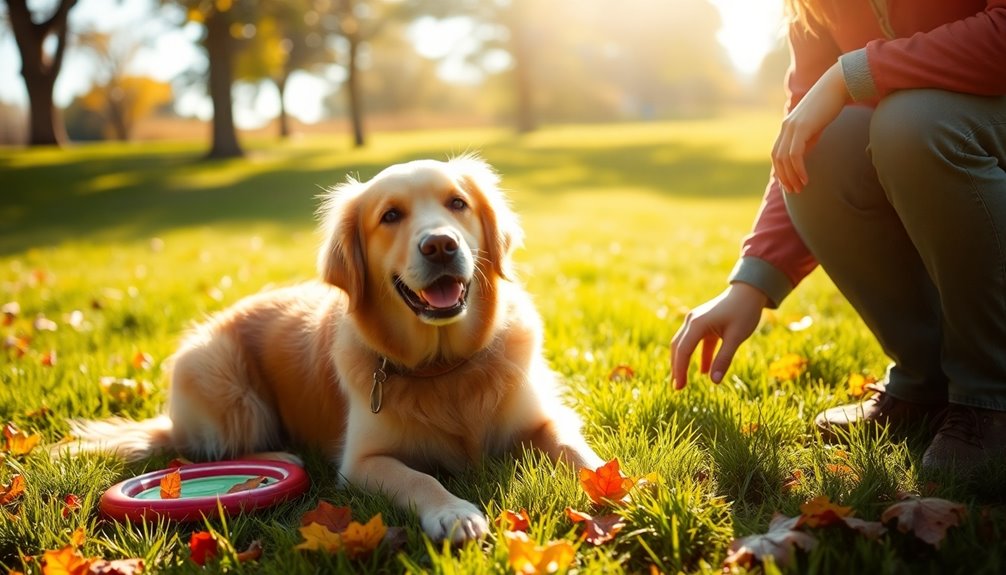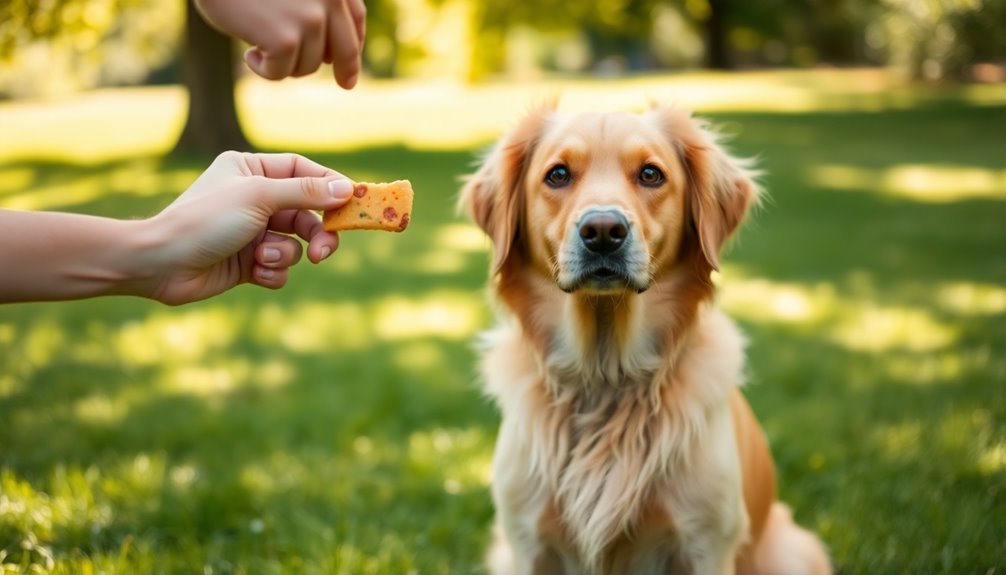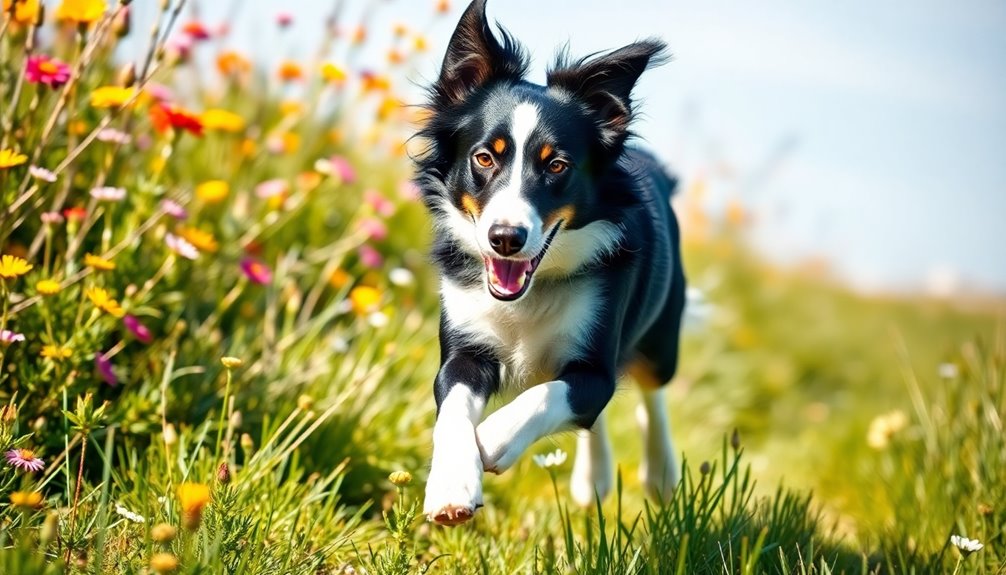If your dog's showing signs of stress like pacing, shaking, or excessive barking, you need to act quickly. Create a calming environment by establishing a safe space where they can retreat. Consider playing soft music or using white noise to drown out distractions. Engage them in physical activities, like a brisk walk or fetch, to help release pent-up energy. Regular mental stimulation through puzzle toys can also alleviate anxiety. If the stress persists, don't hesitate to consult a vet or a certified trainer for tailored advice. Keep exploring ways to help your furry friend feel more secure and relaxed.
Key Takeaways
- Observe your dog for signs of stress, such as pacing, panting, or excessive barking, to identify anxiety levels.
- Create a calming environment by setting up a quiet, distraction-free space with soothing sounds and a comfortable resting area.
- Engage your dog in physical activities and mental challenges to release endorphins and alleviate anxiety effectively.
- Utilize professional resources, like veterinarians or certified trainers, for tailored strategies if anxiety persists.
- Gradually expose your dog to new situations and social environments to improve coping mechanisms and build confidence.
Recognizing Signs of Stress

When you know what to look for, recognizing signs of stress in your dog becomes easier. Stressed dogs often exhibit clear signs of anxiety, including pacing, shaking, or excessive barking. These behaviors may arise from loud noises or changes in their environment.
Pay attention to their body language; panting without exertion, drooling, and weight shifting to the rear legs can signal discomfort or fear.
You should also watch for behavioral changes. If your dog starts shedding more, refuses treats, or displays avoidance behaviors like excessive licking or sniffing, these can be signs of stress.
Familiarizing yourself with your dog's normal demeanor is key; subtle changes in posture, eye, or ear positions can indicate anxiety in dogs.
Recognizing these signs of stress is vital, as around 70% of dogs experience anxiety at some point. Providing a calm place for your dog can help reduce anxiety and create a safe environment for them.
When you spot these indicators, it's important to create a calm place for your dog to help reduce anxiety.
Immediate Calming Techniques
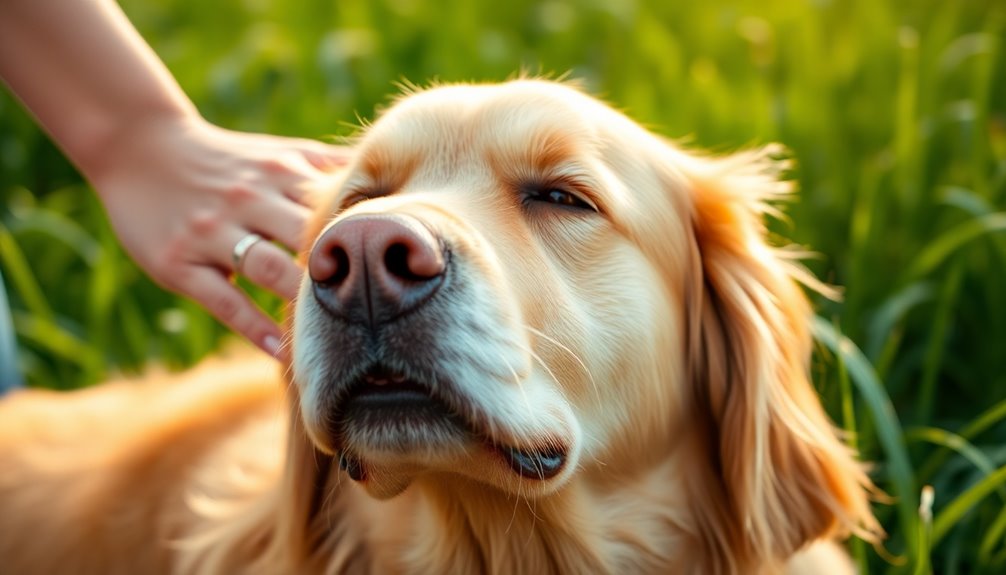
When your dog feels stressed, creating a soothing environment can make a big difference.
You can play calming music or set up a quiet space with their favorite toys to help them relax.
Additionally, quick distraction methods, like engaging in simple training exercises, can redirect their focus and ease anxiety almost instantly. Incorporating calm color palettes in their environment can also foster a peaceful atmosphere.
Soothing Environment Setup
Creating a soothing environment for your dog can greatly reduce their stress and anxiety levels. Start by designating a quiet area where your dog can retreat when they feel overwhelmed. Equip this safe place with comfortable bedding and their favorite toys to help your dog feel secure.
Consider adding calming music or white noise to mask environmental triggers, as soothing sounds can markedly reduce anxiety.
Maintaining a consistent routine for feeding, exercise, and sleep is essential. Predictability provides structure and security, which can help calm your dog and lower their stress.
To enhance the calming atmosphere, incorporate soft lighting and calming scents like lavender. These elements promote relaxation and create a more soothing environment.
You might also want to use pheromone diffusers or sprays that mimic natural calming scents. These can help alleviate stress and create a sense of security in your dog's space. Additionally, providing a safe retreat can help your dog feel more at ease during stressful situations.
Quick Distraction Methods
Stress can manifest in various ways for dogs, and quick distraction methods can be highly effective in providing immediate relief. Engaging your dog in a brief play session with a favorite toy can redirect their focus and reduce stress levels considerably. Physical activity releases endorphins that promote relaxation, helping to calm an anxious pup.
Puzzle toys filled with treats are another great option. These toys provide mental stimulation and distraction, keeping your dog occupied and focused on problem-solving, which alleviates anxiety.
Additionally, playing calming music or white noise can drown out stressful environmental sounds, creating a soothing atmosphere that helps calm your dog.
Implementing simple training commands like "sit" or "stay" can also be beneficial. These commands refocus your dog's attention and provide a sense of structure during stressful moments.
Finally, offering a favorite treat or chew serves as a comforting distraction, allowing your dog to engage in a positive activity that diverts their attention from anxiety triggers. To further enhance your dog's wellness, consider incorporating safe foods like cilantro into their diet, as it can offer additional health benefits.
Creating a Safe Space
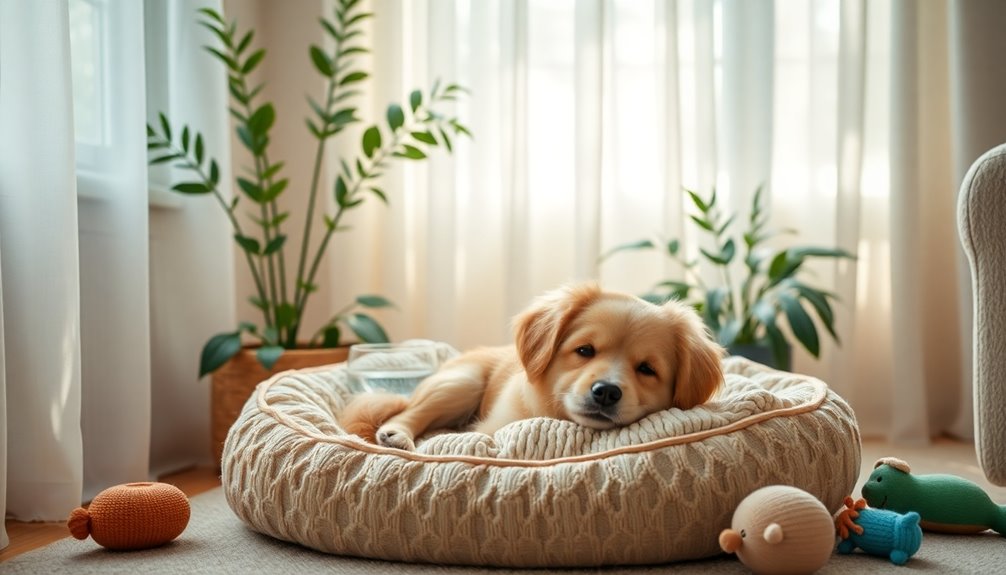
Creating a designated relaxation area for your dog is essential for managing their stress.
By ensuring this space is quiet and free from distractions, you help them feel secure when anxiety strikes.
Adding noise reduction techniques, like soft music or white noise, can further enhance this sanctuary.
Designated Relaxation Area
A designated relaxation area can greatly improve your dog's sense of security and comfort. By creating this safe space, you help calm an anxious dog during stressful situations.
Choose a quiet corner in your home, away from loud noises and distractions. Equip the area with comfortable bedding, familiar toys, and calming scents to enhance relaxation. This setup allows your dog to retreat to a place that feels safe and familiar.
Training the dog to go to this safe space on cue can empower them and provide a sense of control during anxious moments. When your dog learns that this designated relaxation area is their retreat, it promotes a routine that stabilizes their emotional well-being.
Regular access to this area helps them associate it with comfort, further reducing their overall anxiety levels.
Noise Reduction Techniques
During noisy events like thunderstorms or fireworks, implementing noise reduction techniques in your dog's safe space can make all the difference.
Start by creating a designated area filled with comfortable bedding and familiar toys. This retreat will help relieve your dog's anxiety by providing a secure environment. Use soft music or white noise machines to mask loud, triggering noises, creating a calming atmosphere.
Ensure the safe space is free from distractions and has controlled access, so your dog associates it with relaxation. Regular access to this area, combined with positive reinforcement when they use it, encourages them to seek refuge during stressful moments. This association promotes a sense of safety and comfort.
Additionally, consider incorporating calming scents, like lavender, through an oil diffuser. These scents can further soothe your anxious dogs, enhancing the overall calming effects of their safe space.
Utilizing Music and Sounds

Music and soothing sounds can work wonders for a stressed dog. Playing soft music or white noise creates a calming environment that helps mask triggering noises, effectively reducing anxiety levels. Research shows that specific playlists designed for dogs can lower heart rates and promote relaxation, making music an effective tool for stress relief.
Classical music, in particular, has a soothing effect on dogs' nervous systems. It can decrease barking and alleviate stress, helping your furry friend feel more at ease.
Additionally, sound therapy, such as calming nature sounds, provides distraction from anxiety-inducing stimuli, contributing to a sense of security.
Incorporating music or sound into your dog's routine can enhance their overall well-being and support their emotional health, especially during stressful situations like thunderstorms or fireworks.
By creating a peaceful atmosphere filled with soothing sounds, you can help your dog feel more relaxed and at home.
Engaging in Physical Activity
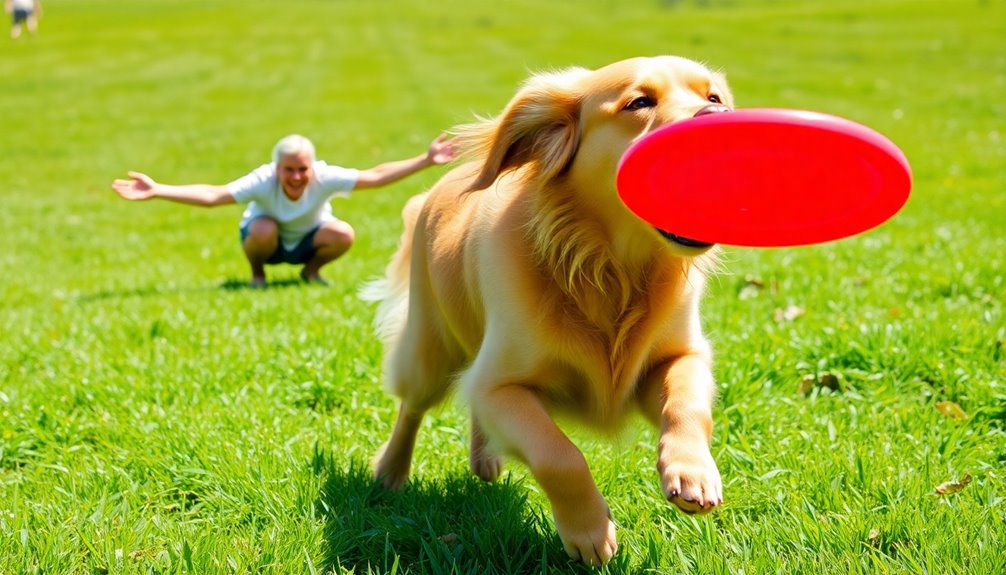
Getting your dog moving can work wonders for reducing stress and anxiety. Engaging in regular physical activity, like daily walks or play sessions, releases endorphins that promote relaxation. This exercise not only lowers your dog's anxiety level but also helps burn off excess energy, essential for preventing stress-related behaviors such as pacing, barking, or destructive actions.
Activities like fetch or tug-of-war provide important physical stimulation and strengthen the bond between you and your dog, enhancing social interaction and comfort. Incorporating consistent routines that include exercise gives your dog a sense of security and predictability, which is critical for managing anxiety effectively.
Additionally, don't underestimate the importance of mental stimulation. Interactive play, such as using puzzle toys, can complement physical activity, keeping your dog engaged and distracted. This combination of exercise and mental challenges can greatly alleviate stress and help your dog feel more relaxed.
Seeking Professional Help
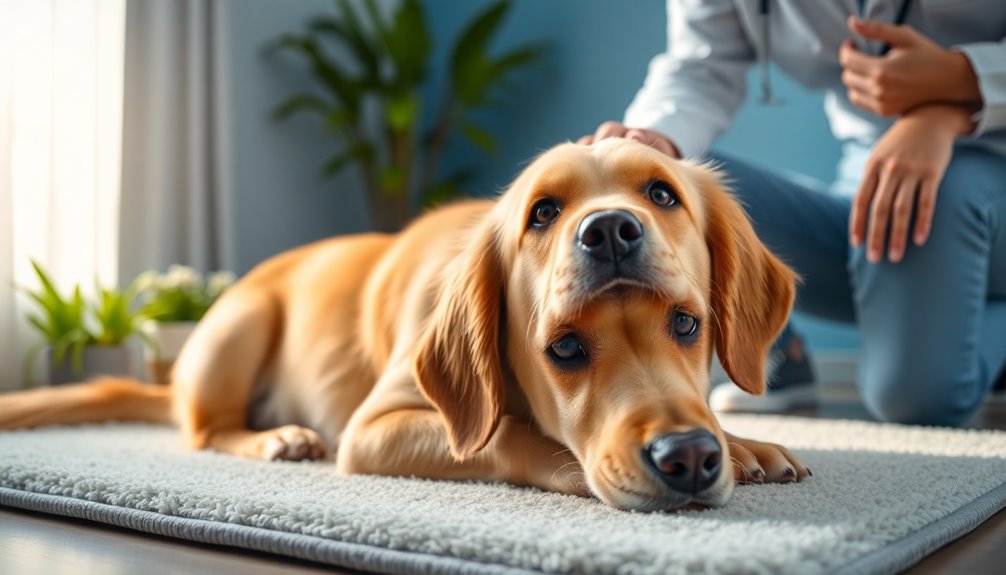
When your dog shows signs of persistent anxiety, seeking professional help can be a game-changer. Consulting a veterinarian is crucial to rule out any underlying health issues that could be contributing to your dog's stress.
Once you've addressed medical concerns, a certified dog trainer or a veterinary behaviorist can provide you with tailored strategies for behavior modification. They'll help you understand your dog's specific anxiety triggers and teach you effective techniques to manage those behaviors.
The AKC GoodDog! Helpline is another excellent resource, offering expert advice specifically focused on dog anxiety. Regular follow-ups with professionals guarantee that the stress relief strategies you implement are effective and allow for necessary adjustments based on your dog's progress.
Consider enrolling your anxious dog in group classes, which can create a controlled environment for socialization. This exposure helps them adapt to new situations and reduces anxiety over time.
Frequently Asked Questions
How Can You Calm a Stressed Dog?
To calm a stressed dog, create a quiet, safe space where they can relax away from distractions.
Engage them in regular exercise like walks or playtime to release pent-up energy.
Consider using calming products, such as pheromone diffusers or Thundershirts®, to ease anxiety.
Gradually desensitize them to triggers with positive reinforcement, and play calming music or white noise to drown out stressful sounds.
These methods can greatly improve their comfort during anxious moments.
How Do You Break Anxiety in a Dog?
To break anxiety in your dog, start with gradual desensitization.
Expose them to anxiety triggers in controlled settings while rewarding calm behavior.
Counter-conditioning can help, too—pair those triggers with treats or play to change their emotional response.
Establish a consistent routine for feeding, exercise, and sleep to provide comfort.
Finally, consider training techniques like a "settle" command or creating a safe space for them to retreat when needed.
How Long Does It Take for a Dog to Get Over Stress?
The time it takes for a dog to recover from stress really depends on several factors.
Generally, acute stress can fade in just a few hours to a day, but chronic stress might linger for weeks or even months.
If your dog faces ongoing stressors, like loud noises, it could take longer to relax.
What to Do When Your Dog Stresses You Out?
When your dog stresses you out, it's essential to take a step back and breathe.
Identify the triggers causing the stress and try to address them calmly. Establishing a routine can help both of you feel more secure.
Engage in activities like walks or playtime to release tension. If you're still feeling overwhelmed, don't hesitate to seek advice from a veterinarian or trainer.
Your well-being is important, too!
Conclusion
In a world where your furry friend sometimes feels a bit overwhelmed, it's crucial to recognize their signals and respond with love and care. By creating a calming environment and engaging in soothing activities, you can help turn their anxious moments into peaceful ones. Remember, every wag of their tail is a reminder of their resilience. So, embrace these gentle techniques, and watch as your pup finds their happy place, transforming stress into serenity.






